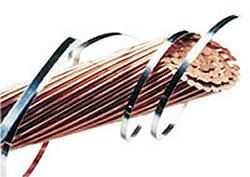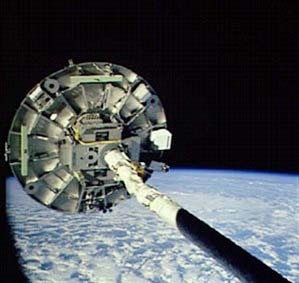|
New research is unlocking the amazing potential
of high-temperature superconductors.
by Patrick L. Barry
Few technologies ever enjoy the sort
of rock-star celebrity that superconductors received in the late
1980s.
Headlines the world over trumpeted the discovery of "high temperature"
superconductors (abbreviated HTS), and the media and scientists
alike gushed over the marvels that we could soon expect from this
promising young technology. Levitating 300-mph trains, ultra-fast
computers, and cheaper, cleaner electricity were to be just the
beginning of its long and illustrious career.
Today we might ask, like a Hollywood
gossip columnist: what ever happened to the "high-temp" hype?
"It was the hottest potato of its
time, but it all fizzled out," says Louis Castellani, president
of the Houston-based HTS company Metal Oxide Technologies, Inc.
(MetOx).
The problem was learning to make wire out of it. These superconductors
are made of ceramics - the same kind of material in coffee mugs.
Ceramics are hard and brittle. Finding an industrial way to make
long, flexible wires out of them was going to be difficult.
Indeed, the first attempts were disappointing.
So-called "first generation" HTS wire was relatively expensive:
5 to 10 times the cost of copper wire. Furthermore, the amount of
current it could carry often fell far short of its potential: only
2 or 3 times that of copper, versus a potential of more than 100
times.

Image courtesy MetOx
"Second
generation" HTS wire can carry the same amount of current
as copper wire hundreds of times as thick.
|
But now, thanks to years of research
involving experiments flown on the space shuttle, this is about
to change.
The NASA-funded Texas Centre for Superconductivity
and Advanced Materials (TcSAM) at the University of Houston is teaming
with MetOx to produce the "smash hit" that scientists have been
seeking since the '80s: a "second generation" HTS wire that realizes
the full 100-fold improvement in current capacity over copper yet
costs about the same as copper to produce.
Once-famous superconductors may be
about to step back into the limelight.
The audience awaits
The special "talent" of superconductors
is that they have zero resistance to electric current. Absolutely
none. In theory, a loop of HTS wire could carry a circling current
forever without even needing a power source to keep it going.
In normal conductors, such as copper
wire, the atoms of the wire impede the free flow of electrons, sapping
the current's energy and squandering it as heat.
Today, about 6 to 7% of the electricity
generated in the United States gets lost along the way to consumers,
partly due to the resistance of transmission lines, according to
U.S. Energy Information Agency documents.
Replacing these lines with superconducting wire would boost utilities'
efficiencies, and would go a long way toward curbing the nation's
greenhouse gas emissions.

MRI scans,
a powerful tool for medical diagnosis, use superconducting
electromagnets to generate detailed images of body tissues.
Most of today's MRI machines require expensive liquid helium
to cool their low-temperature superconducting wire.
|
The fledgling "maglev" train industry
would also welcome the availability of higher-quality, cheaper HTS
wire. Economic realities stalled the initial adoption of maglev
transit systems, but maglev development is still strong in Japan,
China, Germany, and the United States.
NASA is looking at how superconductors
could be used for space. For example, the gyros that keep satellites
oriented could use frictionless bearings made from superconducting
magnets, improving the satellites' precision. Also, the electric
motors aboard spacecraft could be a mere 1/4 to 1/6 the size of
non-superconducting motors, saving precious volume and weight in
the spacecraft's design.
Should we ever establish a base on the moon, superconductors would
be a natural choice for ultra-efficient power generation and transmission,
since ambient temperatures plummet to 100 K (-173 C, -280 F) during
the long lunar night - just the right temperature for HTS to operate.
And during the months-long journey to Mars, a "table top" MRI machine
made possible by HTS wire would be a powerful diagnosis tool to
help ensure the health of the crew.
Worldwide, the current market for HTS
wire is estimated to be US$30 billion, according to Castellani,
and it is expected to grow rapidly.
A backstage pass
The University of Houston has licensed
this new wire-making technology to MetOx, a company founded in 1997.
MetOx plans to begin full-scale production of this high-quality
HTS wire in 2003, Castellani says.
Not surprisingly, the primary scientist
for the NASA group at TcSAM, Dr. Alex Ignatiev, can't reveal exactly
how they make their HTS wire. The technologies springing from these
NASA/industry research partnerships must be patented to achieve
NASA's goal of using space to benefit American businesses, Ignatiev
says.

Image courtesy NASA
The Wake
Shield Facility being held out in space by the shuttle's
robot arm.
|
He will, however, share the dinner-napkin
sketch.
Basically, the wire is made by growing
a thin film of the superconductor only a few microns thick (thousandths
of a millimetre) onto a flexible foundation. This well-known production
method was improved upon in part through "Wake
Shield" experiments flown on the space shuttle to learn about
growing thin films in the hard vacuum of space.
"We learned how to grow higher-quality
oxide thin films from the shuttle experiments, and used that in
the lab to improve the quality of our superconducting films," Ignatiev
says.
In the years to come, that quality
will translate into improvements in dozens of industries from power
generation to medical care. Keep an eye on this one: the glamorous
career of superconductors has only just begun.
|
